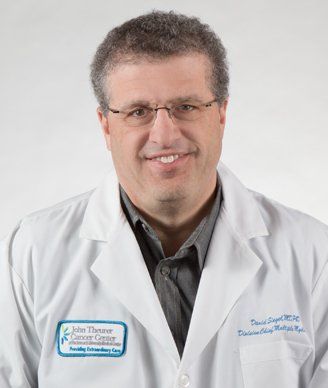Current Treatment Options for Patients With Multiple Myeloma
In this interview we discuss the standard of care and current treatment options for patients with multiple myeloma.
David S. Siegel, MD, PhD

Here we discuss the standard of care and current treatment options for multiple myelomawith David Siegel, MD, PhD, chief of the division of multiple myeloma at the John Theurer Cancer Center at Hackensack University Medical Center in Hackensack, New Jersey.
-Interviewed by Anna Azvolinsky
Cancer Network:First, can you talk about the major mainstay therapies for recently diagnosed multiple myeloma patients who have not had prior therapies?
Dr. Siegel: We have been very fortunate in the last few years to have a number of drugs newly approved for the treatment of multiple myeloma. Rather than there being one therapy, we actually have the dilemma of many treatment options. I think that most of us in the United States tend to treat a newly diagnosed myeloma patient with triplet combinations. Occasionally, we use even more complex combinations but the main triplet that is used for newly diagnosed myeloma patients at this point is the combination of bortezomib, lenalidomide, and dexamethasone. There is also a newer combination of carfilzomib, lenalidomide, and dexamethasone; the third combination used is bortezomib, cyclophosphamide, and dexamethasone. Bortezomib and carfilzomib are proteasome inhibitors, lenalidomide is an immunomodulatory drug (IMID), and dexamethasone is a corticosteroid. Cyclophosphamide is an alkylating agent, which is much more in line with what people think of when they think of chemotherapy drugs. These are the main frontline therapies, and they are very effective. The response rates are well over 90% with these combinations.
Cancer Network:Can these treatment combinations be given to patients indefinitely or are there other options?
Dr. Siegel: Right now the more definitive therapy would be melphalan with a peripheral blood stem cell transplant. Melphalan is the best drug that we have for treating myeloma, and it has been around for a very long time. It is the one drug that we have that has the ability to kill myeloma for some period of time. The problem is it is also very good at killing the normal bone marrow. We need to remove some of the healthy bone marrow cells before we give the melphalan, but we don’t collect those bone marrow cells from the bone marrow anymore. We collect them from the peripheral blood, hence peripheral blood stem cells. We can give a high dose of melphalan, and then give those peripheral blood stem cells back, and the bone marrow will recover very quickly. That is the standard of care for most younger patients with myeloma. For older patients with myeloma, there are a number of choices similar to the ones that I spoke about earlier.
Cancer Network:What are some of the important and most used therapies for relapsed or refractory multiple myeloma patients?
Dr. Siegel: For patients with relapsed disease, the answer is even more complicated than it is for newly diagnosed patients. When I give talks about myeloma I always show a slide on the number of drugs that have been approved in multiple myeloma, and that number has been growing. It used to be that we had only a couple of drugs that were effective, and hence the choices were very few. Now we have a multitude of drugs approved and all of the combinations of these drugs to deal with.
Basically, the options are similar to those for first-line patients. There are the three proteasome inhibitors approved for multiple myeloma: bortezomib, which was the first one approved and remains the most widely used; carfilzomib, which is the most potent of the three and arguably the most potent drug we have for treating myeloma; and ixazomib, a derivative of the original proteasome inhibitor, bortezomib, which can be taken orally. There are IMIDs, which are derivatives of thalidomide-the notorious drug from the 1950s that caused the birth defect phocomelia, which caused children to be born with very short arm and leg stubs. But, it turned out that thalidomide was a very effective drug in treating myeloma. There are two newer derivatives of thalidomide-lenalidomide and pomalidomide, with pomalidomide being the more active drug. However, it is reserved for patients who have already been given other drugs in earlier lines of treatment. The corticosteroids are the other mainstay drugs, of which we have a number of newer ones.
Monoclonal antibodies have taken the myeloma world by storm. We have one called elotuzumab and a second one that is significantly more potent called daratumumab. We have combinations with these drugs, as well as other drugs that are perhaps not in the top tier in regard to their activity but are certainly very important and can be used in very specific circumstances. Again, it is very complicated to answer the question of how to treat a relapsed patient. Thankfully, the reason it is getting more and more complicated is because we have more and more choices of treatments.
Cancer Network:Thank you so much for joining us today, Dr. Siegel.
Dr. Siegel: Thank you, it was my pleasure.
Navigating AE Management for Cellular Therapy Across Hematologic Cancers
A panel of clinical pharmacists discussed strategies for mitigating toxicities across different multiple myeloma, lymphoma, and leukemia populations.